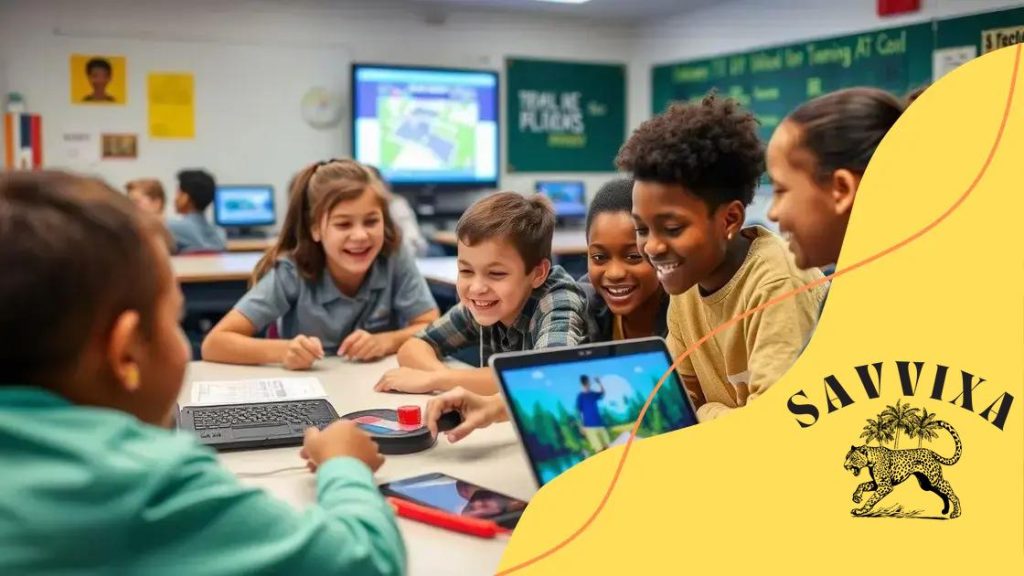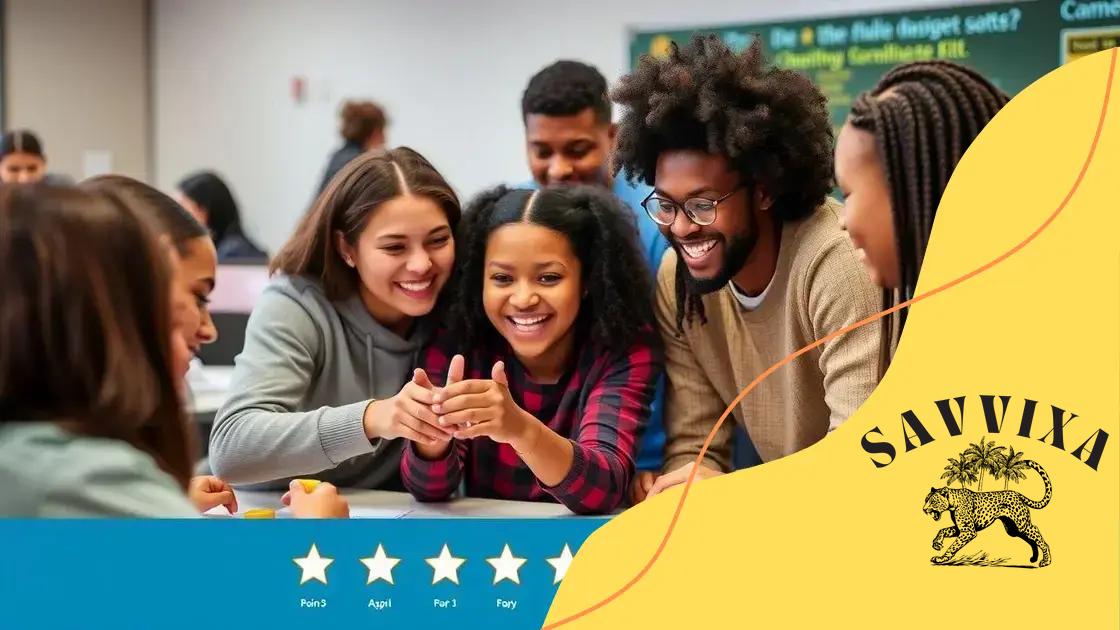Gamification to enhance student motivation

Gamification enhances student motivation in education by integrating game elements into learning activities, leading to increased engagement, improved retention, and effective collaboration among students.
Gamification to enhance student motivation has become a buzzword in educational settings. Have you ever noticed how game-like elements can transform learning experiences? In this article, we’ll delve into how incorporating these strategies can truly revitalize student engagement.
Understanding gamification in education
Understanding gamification in education is essential to create an engaging learning environment. By integrating game elements into the classroom, teachers can spark student interest and encourage active participation. Think of how video games captivate players through challenges and rewards; similar strategies can be harnessed to enhance educational experiences.
Key Components of Gamification
At its core, gamification involves several key components. These elements aim to transform traditional teaching methods into dynamic learning experiences. Let’s explore these components:
- Points: Students earn points for completing tasks or achieving milestones, providing feedback on their progress.
- Badges: Badges are digital rewards that recognize specific achievements, motivating students to reach their goals.
- Leaderboards: Displaying a leaderboard fosters healthy competition among students, encouraging them to improve their performance.
- Challenges: Incorporating challenges helps to make learning more engaging by presenting tasks that require critical thinking and creativity.
Implementing these elements can vary in complexity. For example, a simple points system might involve awarding points for homework completion, while more complex setups could include interactive games that align with educational content. The beauty of gamification lies in its flexibility to adapt to different teaching styles and subject matters.
Benefits of Gamification
Another vital aspect to consider is the wide array of benefits gamification brings to the educational landscape. Beyond mere enjoyment, the use of game mechanics can significantly impact student motivation and engagement. Various studies have highlighted the positive impact of gamification on student learning, such as improved retention and higher participation rates.
Imagine students actively discussing strategies with each other, not just to complete assignments but to enjoy the learning experience itself. This dynamic creates a collaborative atmosphere, where students help one another to succeed. By leveraging gamification, educators can foster a classroom culture rooted in teamwork and mutual respect.
Strategies to implement gamification
Strategies to implement gamification in the classroom can transform student engagement. By using well-planned strategies, teachers can create a vibrant learning environment that motivates students. Understanding various approaches is crucial for effective implementation.
Begin with Your Objectives
Before diving into gamification, it’s essential to establish clear educational objectives. Ask yourself what you want to achieve. This will help guide your gamification strategy. For instance, are you aiming to improve participation, enhance understanding, or foster collaboration? Having a clear focus will shape your approach.
Incorporate Game Elements
Now that you have your objectives in mind, start incorporating specific game elements. Consider using:
- Point Systems: Assign points for completed assignments or collaborative tasks to encourage participation.
- Rewards and Badges: Offer badges for accomplishments. This visual recognition can motivate students to reach new goals.
- Challenges: Design challenges that require critical thinking and creativity. These can be team-based to enhance collaboration.
- Storytelling: Weave a story into your lessons to engage students’ imaginations and create a sense of adventure.
Each element adds a layer of excitement and encourages students to take part in their learning journey. It can help create a more immersive environment where learning feels like play rather than work.
Create a Balanced Experience
A successful gamification strategy balances enjoyable game mechanics with meaningful educational content. It’s crucial to ensure students are not just playing, but learning. Use regular assessments to gauge students’ understanding and adjust your approach accordingly. This can involve tracking their progress and providing feedback, allowing them to see improvements over time.
Engagement levels can rise significantly when students see their efforts leading to accomplishments. Keep the atmosphere fun, but focused. Continuous adaptation ensures that all students, regardless of their skill levels, can benefit and find success.
Benefits of gamification for student motivation

Benefits of gamification for student motivation include a variety of positive effects that can enhance the educational experience. By integrating game mechanics into learning, students often find the process more enjoyable and engaging. This approach not only makes learning fun but also increases the desire to participate.
Increased Engagement
One major benefit is the increase in student engagement. When students are involved in gamified activities, they become active participants rather than passive recipients of information. For example, a classroom that utilizes challenges and rewards fosters an environment where students are excited to learn.
Improved Retention of Information
This exciting atmosphere can also lead to better retention of information. When students learn through games, they create memories associated with the positive feelings of success. This method allows for practical application of concepts, making them more relatable and easier to remember.
Moreover, gamification allows students to face challenges in a safe environment. As they navigate these challenges, they develop critical thinking skills. They learn to strategize and adapt, which can boost their confidence in their abilities.
Fostering Collaboration
Another significant advantage of gamification is its ability to encourage teamwork. Many gamified activities involve group challenges that require collaboration. Students learn to work together, share ideas, and develop teamwork skills that are vital for success in the real world.
This social aspect of learning builds a strong classroom community where students feel valued and supported. As they collaborate, they also learn from one another, enhancing their understanding of the subject matter. All these factors contribute to a richer educational experience.
Boosting Motivation
Lastly, gamification taps into the intrinsic motivation of students. By providing immediate feedback, rewards, and recognition, students feel more accomplished and motivated to improve. The sense of achievement that comes from reaching levels, earning badges, or winning competitions keeps students engaged and eager to learn. Overall, these elements foster a love for learning that can last a lifetime.
Challenges in applying gamification
Challenges in applying gamification can impact the effectiveness of this approach in education. While gamification offers numerous benefits, it also presents obstacles that educators must navigate. Understanding these challenges is crucial for successful implementation.
Understanding Student Needs
One significant challenge is accurately assessing the needs and interests of students. Every student is different, and what motivates one student may not resonate with another. This diversity can make it difficult for teachers to design gamified experiences that appeal to the entire class. Additionally, misaligned games can lead to disengagement rather than increased motivation.
Resource and Time Constraints
Another barrier educators often face is limited resources, including time and technology. Implementing gamification requires careful planning and sometimes technical skills that may not be present in every classroom. Teachers might need to invest extra hours to create engaging content, leaving less time for other essential teaching duties.
- Technology Requirements: Not all classrooms have access to the technology needed for interactive gamified lessons.
- Training Needs: Teachers may require professional development on how to effectively incorporate gamification into their teaching.
- Cost Considerations: Some gamification tools and software may come with a price tag that schools cannot afford.
These resource constraints can hinder the thoughtful implementation of gamified learning experiences, making it essential for educators to address these factors before proceeding.
Balancing Fun and Education
Another significant challenge lies in maintaining the perfect balance between fun and educational value. If gamification becomes too focused on entertainment, it may detract from learning objectives. It’s crucial to ensure that the game elements enhance learning rather than overshadow it. Teachers need to continually assess whether students are benefiting from the gamified activities.
Moreover, constant adjustments may be necessary as students progress. This continuous evaluation can be time-consuming but is essential for effective gamification.
Measuring the effectiveness of gamification
Measuring the effectiveness of gamification is crucial for determining how well these strategies are working in the classroom. Without proper metrics, it can be difficult to see if gamified activities lead to improved learning outcomes and student engagement. Understanding how to evaluate these strategies is key to making necessary adjustments.
Setting Clear Objectives
The first step in measuring effectiveness is to set clear objectives. Educators should define what success looks like for their gamification efforts. Are you aiming to increase participation rates, improve understanding of material, or enhance teamwork skills? By establishing these goals, you can better gauge whether your gamification efforts are successful.
Using Assessments
Effective assessments are also vital for measuring outcomes. Formative assessments, such as quizzes and reflective journals, can provide immediate feedback on student understanding. Educators can analyze these assessments to see if students are benefiting from gamified learning experiences. Additionally, summative assessments at the end of a unit can gauge overall knowledge retention and skill acquisition.
- Peer Feedback: Encourage students to provide feedback on their experiences with gamified activities. This can reveal areas for improvement.
- Observational Data: Teachers can observe student engagement during gamified activities and compare it to traditional lessons.
- Performance Metrics: Track changes in test scores or participation before and after implementing gamification to assess impact.
These evaluation methods can provide valuable insights into how gamified strategies affect student learning.
Analyzing Data
Once data is collected, it’s essential to analyze it meaningfully. Look for patterns that indicate improvement in learning and engagement. For example, if participation increases significantly during gamified lessons, this could suggest that the approach is working. However, if scores do not improve, it may signal that adjustments are needed.
Continuous data analysis allows educators to refine their gamification strategies. By adapting to the insights gathered, they can enhance the overall learning experience for their students.
FAQ – Frequently Asked Questions about Gamification in Education
What is gamification in education?
Gamification in education refers to integrating game elements into learning activities to enhance student engagement and motivation.
How can I measure the effectiveness of gamification?
You can measure the effectiveness by tracking student participation, assessing understanding through quizzes, and collecting feedback on their experiences.
What are some benefits of using gamification in the classroom?
Benefits include increased student engagement, improved retention of information, fostering collaboration, and boosting intrinsic motivation.
What challenges might I face when implementing gamification?
Challenges may include resource constraints, balancing fun with educational objectives, and accurately assessing student needs.